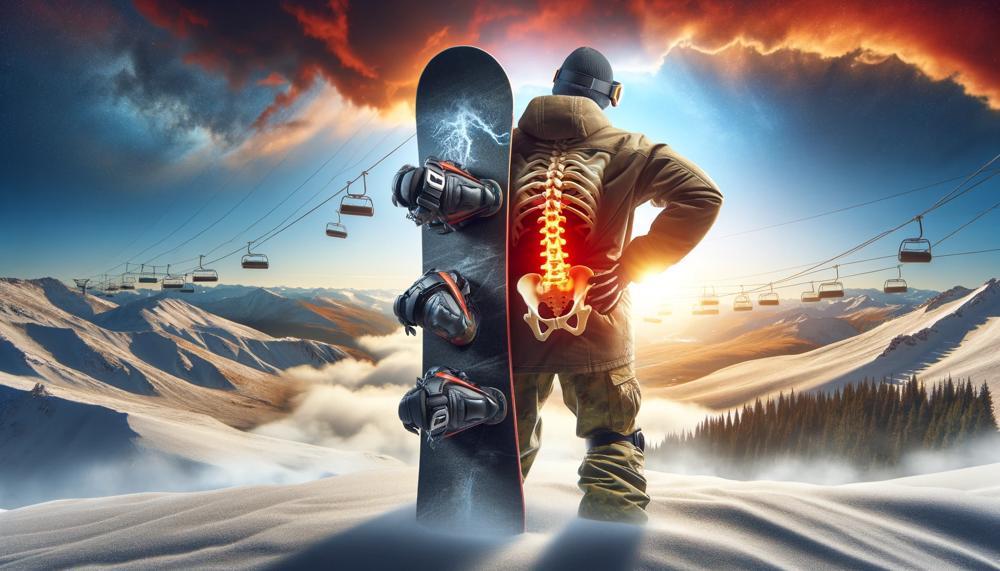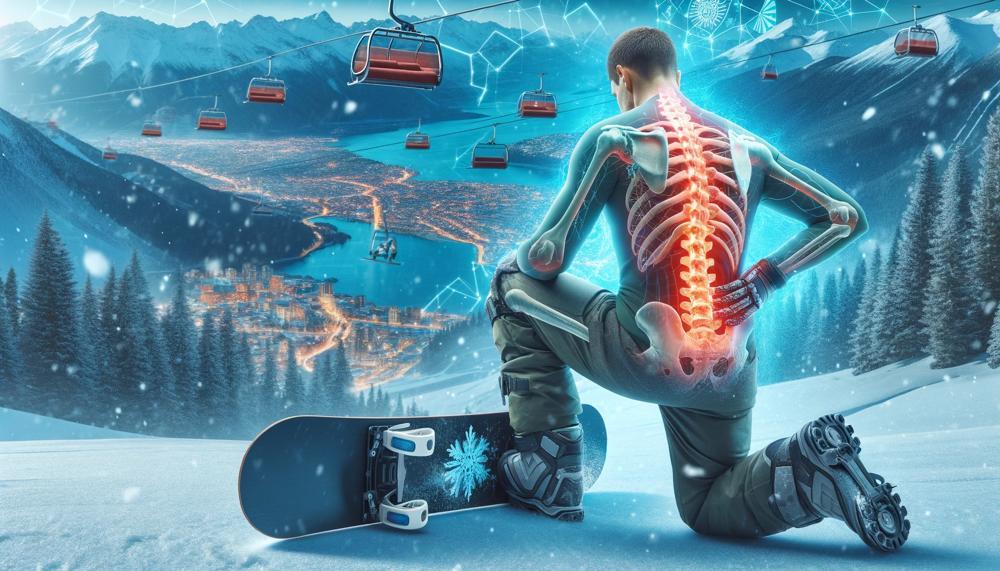As winter creeps in, many of us are itching to hit the slopes and indulge in some thrilling snowboarding adventures. The rush of flying through fresh powder and soaring off jumps is undeniably alluring for snowboarders. However, like any sport, there are risks involved. And one aspect that often goes unnoticed is the impact of snowboarding on your back.
So, is snowboarding bad for your back?
Yes, snowboarding can be bad for your back. Snowboarding can put stress on your lower back and spinal discs. The bending, twisting, and bouncing motions of snowboarding can contribute to back overuse injuries. The “bouncing”, vibration, or pressure downward onto an immovable surface (the ground) also stresses the components of the spine. According to a 2019 issue of Current Sports Medicine Reports, spinal injuries account for as much as 17 percent of all traumas on the slopes. The lumbar spine is the most commonly involved among skiers and snowboarders alike. Without proper preparation, back pain can occur during snowboarding. To avoid injury and back pain when you’re riding down the slope, you can make sure you look out for obstacles in your path, such as tree branches, rocks, or fences.
While snowboarding can be an invigorating workout and an adrenaline-fueled adventure, it’s crucial to understand its potential effects on your back. In this blog post, we will delve into how snowboarding may affect your back and provide tips for preventing injuries and maintaining a healthy spine while shredding down the slopes.
So, grab a cup of hot cocoa and let’s dive into this topic.
Is Snowboarding Bad For Your Back? How Snowboarding Affects You
Contents
Snowboarding is a sport that can have both positive and negative effects on the health of your back and spine. The physical demands, equipment used, weather conditions, and individual differences all play a role in how snowboarding affects these areas.
Below is a table summarizing the potential impacts of snowboarding on the back and spine.
| Positive Effects | Negative Effects |
| Strengthens back muscles | Can cause lower back pain |
| Improves posture | May result in herniated discs |
| Reduces risk of back pain | Can lead to strains or sprains |
| – | Spinal injuries due to falls or collisions |
| – | Poorly fitted equipment can strain the back |
| – | Riding on icy or hard-packed snow can cause injury |
| – | Individual differences such as age, fitness level, and pre-existing conditions can impact how snowboarding affects the back and spine. |
While snowboarding offers many benefits, it is important for snowboarders to be aware of the potential risks to their back and spine.
Proper conditioning, using well-fitted equipment, and adjusting riding technique according to weather conditions can help minimize these risks.
How Can You Protect Your Back When Snowboarding?
If you want to protect your back while snowboarding, there are several effective strategies you can implement. One of the most efficient ways is by utilizing a back brace. This device is designed to support your spine and reduce strain on your back muscles, particularly during jumps and turns. However, it’s crucial to note that wearing a back brace does not give you the freedom to attempt jumps or tricks that are beyond your skill level.
In addition to using protective gear, it’s essential to focus on building your strength and endurance through various exercises. Activities that improve balance and core stability, such as yoga and Pilates, can significantly benefit your back health while snowboarding. Furthermore, incorporating cardiovascular endurance exercises into your routine can enhance your overall strength and stamina, reducing the likelihood of fatigue-related accidents on the slopes.
Strengthening your legs and abdomen muscles is also crucial in protecting your back while snowboarding. These muscles play a significant role in supporting your spine, so performing exercises like squats and planks regularly can greatly benefit you. Additionally, focusing on core stability exercises like planks, side planks, and Russian twists can help improve balance and strengthen your core.
It’s important to keep in mind that preventing back injuries while snowboarding requires a combination of protective gear, regular exercise, and caution when attempting new tricks.
How Long Does It Take To Recover From Snowboarding Back Pain?
The recovery time for back pain caused by snowboarding can vary depending on the severity of the discomfort and the individual’s overall health and fitness level. However, it can take anywhere from a few days to a couple of weeks for the pain to subside and for full recovery to occur, with factors such as age, previous injuries or conditions, and the intensity of the snowboarding activity also playing a role in the duration of recovery.
To ensure a faster recovery from back pain caused by snowboarding, here are some tips:
- Stretching: After a day of hitting the slopes, it is vital to stretch your muscles to reduce tightness and improve blood circulation. Focus on stretching your back, legs, and core muscles to alleviate any tension.
- Heat therapy: Relaxing in a hot tub or taking an Epsom salt bath can do wonders for sore muscles and promote faster recovery.
- Cold therapy: While it may be uncomfortable, applying ice or cold packs on the affected area can significantly reduce inflammation and pain in muscles.
- Hydration: Staying hydrated is crucial for muscle repair and avoiding muscle cramps during snowboarding. Make sure to replenish electrolytes by drinking sports drinks or eating potassium-rich bananas.
- Massage and foam rolling: These techniques can aid in muscle relaxation and release tension. They can also help prevent future injuries by improving flexibility.
- Compression wraps: Using compression wraps on sore muscles overnight can help reduce inflammation and speed up recovery.
- Get enough rest: It is essential to get enough sleep for muscle repair, but make sure to couple it with stretching or cold therapy before bed.
By following these tips before and after snowboarding, you can prevent extreme soreness and injury, leading to a quicker recovery time. Remember to always listen to your body and avoid pushing yourself too hard while snowboarding to prevent back pain in the first place.
My Favorite Snowboard Gear
To safeguard your back while snowboarding, it is crucial to invest in high-quality protective gear. Here are my top recommendations for the essential gear that will effectively protect your back:
| Helmet | The most vital piece of gear for all riders, a helmet safeguards your head from potential injuries caused by falls or collisions. |
| Wrist guards | Especially important for beginners or riders who fall frequently, wrist guards help prevent wrist injuries from catching an edge. |
| Knee pads | Varying in thickness, knee pads provide extra protection during falls and are particularly useful for park or rail riding. |
| Back protector | Worn like a backpack over base layers, a back protector shields against impacts and bruises during freeriding or backcountry riding. |
| Padded shorts | Strategically placed padding on padded shorts helps cushion falls on the thighs, hips, and tailbone. |
| Knee braces | A low-profile option for added support and protection without restricting movement, knee braces can be worn under snowboard pants. |

By investing in these crucial gear pieces, you can ensure that your back is well-protected while snowboarding. It is also important to remember to properly stretch, use heat and cold therapy, stay hydrated, massage and foam roll, use compression wraps, and get enough rest to prevent extreme soreness and injury.
Taking care of your body and gearing up properly is essential for a fun and safe snowboarding experience.
Also Read: Do You Need To Wax A New Snowboard?
Conclusion
In conclusion, while snowboarding can offer an adrenaline-fueled rush and a fantastic workout, it’s crucial to be mindful of its potential impact on your back.
The constant twisting and turning movements, falls and crashes, and lack of proper form or conditioning can all contribute to back pain or injury.
However, by incorporating stretching exercises, using appropriate gear, and building strength in key areas, you can minimize these risks and safeguard your back.






